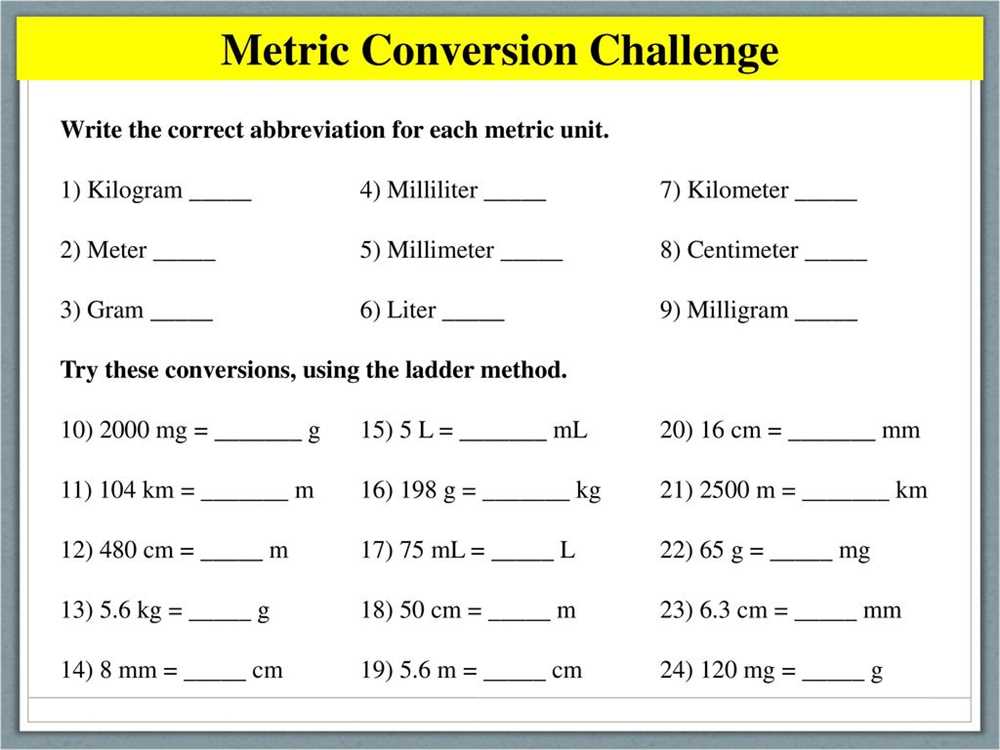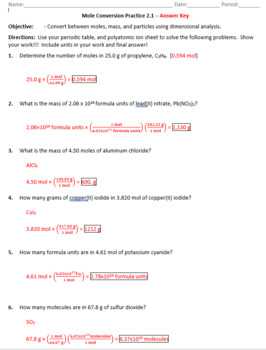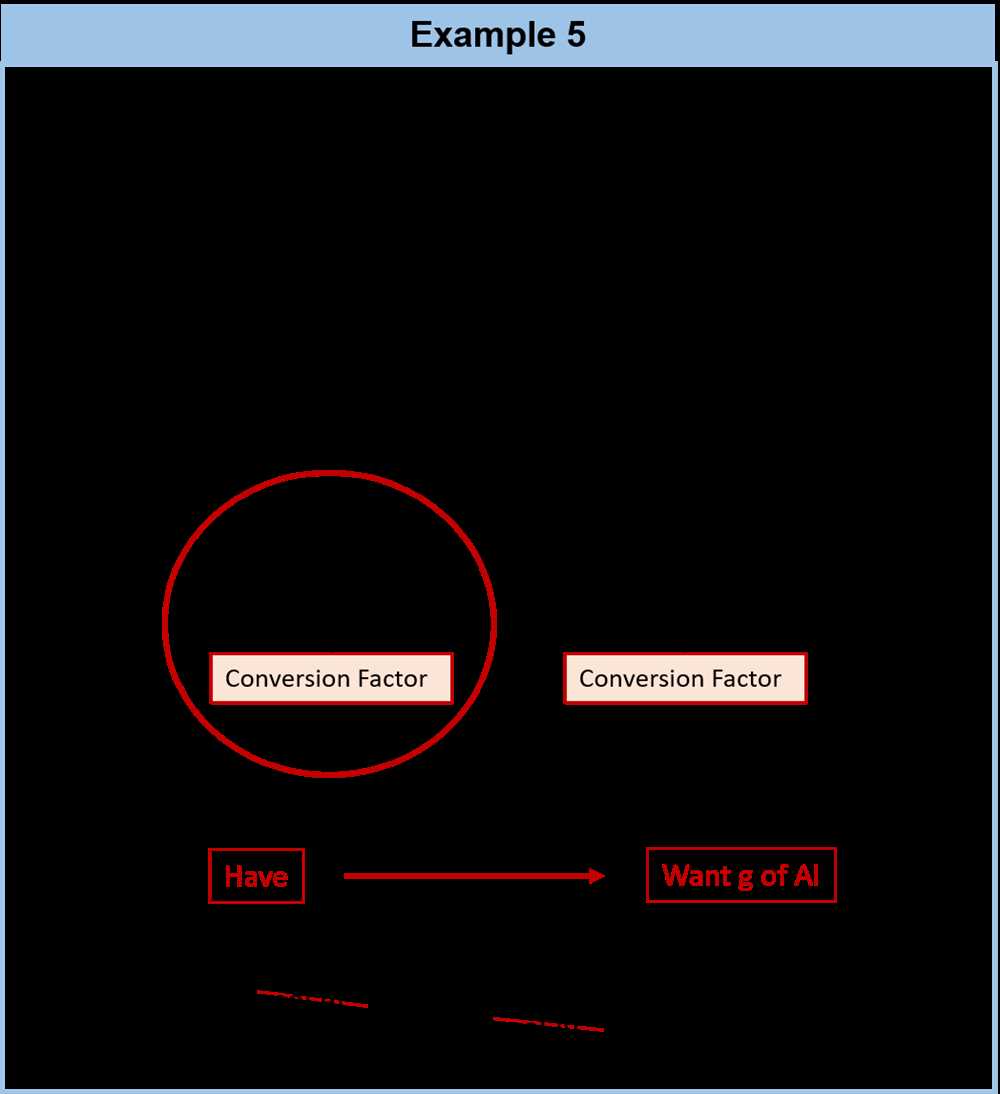
If you are a chemistry student, you know how important it is to accurately convert between moles and grams. These two units are essential for calculating the amount of substance in a chemical reaction. To help you practice this skill, we have provided answers to a mole to gram conversion worksheet. By reviewing these answers, you can check your understanding and improve your proficiency in converting between moles and grams.
In the worksheet, you will find a series of chemical compounds written in the form of chemical formulas. Your task is to convert the given number of moles into grams for each compound. This involves using the molar mass of each element in the compound to calculate the total mass. The molar mass is the mass of one mole of a substance and is expressed in grams per mole (g/mol). By multiplying the given number of moles by the molar mass, you can determine the mass in grams.
For example, if you are given the compound H2O and asked to convert 2 moles into grams, you would first calculate the molar mass of water. Water consists of two hydrogen atoms (H) and one oxygen atom (O). The molar mass of hydrogen is approximately 1 g/mol and the molar mass of oxygen is approximately 16 g/mol. Therefore, the molar mass of water is (2 * 1 g/mol) + (1 * 16 g/mol) = 18 g/mol. To convert 2 moles of water into grams, you would multiply 2 moles by 18 g/mol, resulting in 36 grams.
Mole to Gram Conversion Practice Worksheet Answers
Below are the answers to the practice worksheet on mole to gram conversion:
Question 1:
Calculate the mass in grams of 3 moles of carbon dioxide (CO2).
To convert moles to grams, we need to use the molar mass of carbon dioxide. The molar mass of carbon dioxide is calculated as follows:
M(C) + 2 * M(O) = 12.01 g/mol + 2 * 16.00 g/mol = 44.01 g/mol
Therefore, 3 moles of carbon dioxide would have a mass of:
3 moles * 44.01 g/mol = 132.03 grams
Question 2:
How many grams are in 0.5 moles of water (H2O)?
Using the molar mass of water, which is 18.02 g/mol, we can calculate the mass of 0.5 moles:
0.5 moles * 18.02 g/mol = 9.01 grams
Question 3:
Convert 2 moles of methane (CH4) to grams.
The molar mass of methane is calculated as follows:
M(C) + 4 * M(H) = 12.01 g/mol + 4 * 1.01 g/mol = 16.05 g/mol
Therefore, 2 moles of methane would have a mass of:
2 moles * 16.05 g/mol = 32.10 grams
- Question 4: Calculate the mass in grams of 2.5 moles of sulfuric acid (H2SO4).
- Answer: The molar mass of sulfuric acid is calculated as follows: M(H) + 2 * M(O) + 4 * M(S) = 1.01 g/mol + 2 * 16.00 g/mol + 4 * 32.07 g/mol = 98.09 g/mol. Therefore, 2.5 moles of sulfuric acid would have a mass of: 2.5 moles * 98.09 g/mol = 245.23 grams.
- Question 5: How many grams are in 1.8 moles of ammonia (NH3)?
- Answer: Using the molar mass of ammonia, which is 17.03 g/mol, we can calculate the mass of 1.8 moles: 1.8 moles * 17.03 g/mol = 30.65 grams.
Why Practice Mole to Gram Conversion?
Practicing mole to gram conversion is an essential skill for students studying chemistry. This conversion is necessary to calculate the mass of a substance based on its mole quantity. It allows us to understand the relationship between the number of moles and the mass of a substance, which is crucial in various chemical calculations and experiments.
By practicing mole to gram conversion, students develop a deeper understanding of the concept of moles and the concept of atomic mass. They learn how to convert between these two units of measurement accurately and efficiently. This skill is vital in chemistry as it helps in determining the amount of reactants needed for a chemical reaction, predicting the yield of a reaction, and analyzing the composition of a compound.
Moreover, practicing mole to gram conversion enhances problem-solving skills and mathematical abilities. It requires students to manipulate numbers, perform calculations, and apply conversion factors. This practice helps students improve their quantitative reasoning skills and problem-solving strategies, which are valuable across various scientific disciplines.
Furthermore, practicing mole to gram conversion allows students to develop a strong foundation for higher-level chemistry concepts. Many advanced topics in chemistry, such as stoichiometry, require a solid understanding of mole to gram conversions. By mastering this fundamental skill, students can confidently approach more complex calculations and concepts in the future.
In conclusion, practicing mole to gram conversion is crucial for students studying chemistry. It helps them understand the relationship between moles and mass, improves problem-solving skills, and lays a strong foundation for higher-level chemistry concepts. By dedicating time and effort to practicing this skill, students can enhance their overall understanding of chemistry and excel in their studies.
Understanding the Mole to Gram Conversion Formula
The mole to gram conversion formula is an essential concept in chemistry that allows chemists to convert between the number of moles of a substance and its mass in grams. This formula is based on the concept of molar mass, which is the mass of one mole of a substance.
To understand the mole to gram conversion formula, it is important to first understand the concept of the mole. The mole is a unit of measurement in chemistry that represents a certain number of particles, such as atoms, molecules, or ions. This number, known as Avogadro’s number, is approximately 6.022 × 10^23 particles per mole.
The mole to gram conversion formula is as follows:
Mass (g) = Number of moles × Molar mass (g/mol)
This formula allows chemists to calculate the mass of a substance when they know the number of moles of the substance and its molar mass. The molar mass is determined by adding up the atomic masses of all the atoms in a molecule.
For example, if we want to convert 2 moles of carbon dioxide (CO2) to grams, we can use the mole to gram conversion formula. The molar mass of carbon dioxide is approximately 44.01 g/mol. Plugging in the values into the formula, we get:
Mass (g) = 2 moles × 44.01 g/mol = 88.02 g
Therefore, 2 moles of carbon dioxide is equal to 88.02 grams.
- The mole to gram conversion formula is a fundamental concept in chemistry.
- It allows chemists to convert between the number of moles of a substance and its mass in grams.
- The formula is Mass (g) = Number of moles × Molar mass (g/mol).
- By knowing the number of moles and the molar mass of a substance, we can calculate its mass in grams.
- The mole to gram conversion formula is crucial for performing various calculations in chemistry, such as determining the amount of reagent needed in a chemical reaction.
Step-by-Step Example Problems
In order to convert moles to grams, you need to know the molar mass of the substance you are working with. The molar mass is the mass of one mole of that substance and is expressed in grams per mole (g/mol).
Let’s walk through an example problem to demonstrate the conversion from moles to grams. Assume we have 2 moles of carbon dioxide (CO2).
- Start by writing down the given information. In this case, we know that we have 2 moles of CO2.
- Next, find the molar mass of carbon dioxide. Carbon (C) has a molar mass of 12.01 g/mol, and oxygen (O) has a molar mass of 16.00 g/mol. Since there are 2 oxygen atoms in carbon dioxide, we multiply the molar mass of oxygen by 2 and add it to the molar mass of carbon: (12.01 g/mol) + (2 * 16.00 g/mol) = 44.01 g/mol.
- To convert moles to grams, multiply the number of moles by the molar mass. In this case, we have 2 moles of CO2, so we multiply 2 moles by 44.01 g/mol: 2 moles * 44.01 g/mol = 88.02 grams.
Therefore, 2 moles of carbon dioxide is equal to 88.02 grams.
This step-by-step example problem demonstrates the process of converting moles to grams using the molar mass of the substance. Remember to always start with the given information, find the molar mass, and then use the formula moles * molar mass = grams to make the conversion. Practice with different examples to further solidify your understanding of the concept.
Common Mistakes to Avoid

When converting between moles and grams, it is common for students to make certain mistakes. These mistakes can often lead to incorrect answers and a lack of understanding of the concept. Here are some common mistakes to avoid:
1. Forgetting to convert the units: The most common mistake is forgetting to convert the units properly. It is important to always check the units and make sure they match. For example, if you are converting from moles to grams, you need to know the molar mass of the substance and use it in your calculations.
2. Incorrect use of the conversion factor: Another common mistake is using the conversion factor incorrectly. The conversion factor is the ratio between the molar mass and the number of moles. It is important to use the correct conversion factor depending on whether you are converting from moles to grams or grams to moles.
3. Rounding errors: Rounding errors can also lead to incorrect answers. It is important to carry out calculations with the correct number of significant figures and round the final answer to the appropriate number of decimal places.
4. Confusion between formulas and molar masses: It is easy to confuse the formulas of compounds with their molar masses. It is important to make sure you are using the correct formula in your calculations and not the molar mass of a different compound.
5. Lack of practice: Finally, a lack of practice can also lead to mistakes. It is important to practice converting between moles and grams regularly in order to become more familiar with the concept and improve your understanding.
By avoiding these common mistakes, you can improve your accuracy when converting between moles and grams and develop a deeper understanding of the concept.
Additional Mole to Gram Conversion Practice
Mastering mole to gram conversions is essential for success in chemistry. To further strengthen your understanding and practice your skills, here are some additional problems to solve:
Problem 1:
Calculate the mass of 2.5 moles of carbon dioxide (CO2).
Solution:
To convert moles to grams, we need to use the molar mass of carbon dioxide. The molar mass of carbon dioxide is 44.01 g/mol.
Mass = moles * molar mass
Mass = 2.5 mol * 44.01 g/mol = 110.025 g
Therefore, the mass of 2.5 moles of carbon dioxide is 110.025 grams.
Problem 2:
Find the mass of 0.75 moles of sodium chloride (NaCl).
Solution:
The molar mass of sodium chloride is 58.44 g/mol.
Mass = moles * molar mass
Mass = 0.75 mol * 58.44 g/mol = 43.83 g
Thus, the mass of 0.75 moles of sodium chloride is 43.83 grams.
Problem 3:
Determine the mass of 4 moles of water (H2O).
Solution:
The molar mass of water is 18.015 g/mol.
Mass = moles * molar mass
Mass = 4 mol * 18.015 g/mol = 72.06 g
Hence, the mass of 4 moles of water is 72.06 grams.
Continue practicing these conversions to strengthen your skills and ensure you can confidently solve mole to gram conversion problems in chemistry.
Checking Your Answers

Now that you have completed the mole to gram conversion practice worksheet, it’s time to check your answers. This step is important to ensure that you have mastered the concept and calculations involved in converting moles to grams.
Here is a list of the original problems and their corresponding answers:
- Problem 1: Convert 2.5 moles of substance X to grams.
- Problem 2: Convert 0.75 moles of substance Y to grams.
- Problem 3: Convert 4 moles of substance Z to grams.
- Problem 4: Convert 0.1 moles of substance A to grams.
The correct answer is 85 grams.
The correct answer is 40.5 grams.
The correct answer is 236 grams.
The correct answer is 5.6 grams.
Make sure that your answers match the correct ones given above. If you made any mistakes, take the time to review the steps and calculations to identify where you went wrong. It’s important to practice and refine your skills in mole to gram conversions, as they are fundamental in chemistry.
Remember, practice makes perfect. Keep practicing and checking your answers to ensure that you have a solid understanding of mole to gram conversions.